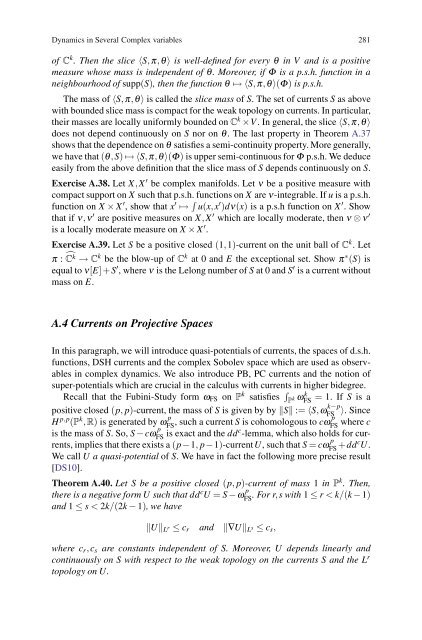Discrete Holomorphic Local Dynamical Systems
Discrete Holomorphic Local Dynamical Systems
Discrete Holomorphic Local Dynamical Systems
Create successful ePaper yourself
Turn your PDF publications into a flip-book with our unique Google optimized e-Paper software.
Dynamics in Several Complex variables 281<br />
of C k . Then the slice 〈S,π,θ〉 is well-defined for every θ in V and is a positive<br />
measure whose mass is independent of θ. Moreover, if Φ is a p.s.h. function in a<br />
neighbourhood of supp(S), then the function θ ↦→〈S,π,θ〉(Φ) is p.s.h.<br />
The mass of 〈S,π,θ〉 is called the slice mass of S. The set of currents S as above<br />
with bounded slice mass is compact for the weak topology on currents. In particular,<br />
their masses are locally uniformly bounded on Ck ×V. In general, the slice 〈S,π,θ〉<br />
does not depend continuously on S nor on θ. The last property in Theorem A.37<br />
shows that the dependence on θ satisfies a semi-continuity property. More generally,<br />
we have that (θ,S) ↦→〈S,π,θ〉(Φ) is upper semi-continuous for Φ p.s.h. We deduce<br />
easily from the above definition that the slice mass of S depends continuously on S.<br />
Exercise A.38. Let X,X ′ be complex manifolds. Let ν be a positive measure with<br />
compact support on X such that p.s.h. functions on X are ν-integrable. If u is a p.s.h.<br />
function on X × X ′ , show that x ′ ↦→ � u(x,x ′ )dν(x) is a p.s.h function on X ′ .Show<br />
that if ν,ν ′ are positive measures on X,X ′ which are locally moderate, then ν ⊗ ν ′<br />
is a locally moderate measure on X × X ′ .<br />
Exercise A.39. Let S be a positive closed (1,1)-current on the unit ball of Ck .Let<br />
π : � Ck → Ck be the blow-up of Ck at 0 and E the exceptional set. Show π∗ (S) is<br />
equal to ν[E]+S ′ ,whereνistheLelong number of S at 0 and S ′ is a current without<br />
mass on E.<br />
A.4 Currents on Projective Spaces<br />
In this paragraph, we will introduce quasi-potentials of currents, the spaces of d.s.h.<br />
functions, DSH currents and the complex Sobolev space which are used as observables<br />
in complex dynamics. We also introduce PB, PC currents and the notion of<br />
super-potentials which are crucial in the calculus with currents in higher bidegree.<br />
Recall that the Fubini-Study form ωFS on Pk satisfies �<br />
Pk ωk FS = 1. If S is a<br />
positive closed (p, p)-current, the mass of S is given by by �S� := 〈S,ω k−p<br />
FS 〉.Since<br />
H p,p (Pk ,R) is generated by ω p<br />
p<br />
FS , such a current S is cohomologous to cωFS where c<br />
is the mass of S.So,S − cω p<br />
FS is exact and the ddc-lemma, which also holds for currents,<br />
implies that there exists a (p−1, p−1)-currentU, such that S = cω p<br />
FS +ddcU. We call U a quasi-potential of S. We have in fact the following more precise result<br />
[DS10].<br />
Theorem A.40. Let S be a positive closed (p, p)-current of mass 1 in Pk . Then,<br />
there is a negative form U such that ddcU = S − ω p<br />
FS .Forr,swith 1 ≤ r < k/(k −1)<br />
and 1 ≤ s < 2k/(2k − 1), we have<br />
�U�Lr ≤ cr and �∇U�L s ≤ cs,<br />
where cr,cs are constants independent of S. Moreover, U depends linearly and<br />
continuously on S with respect to the weak topology on the currents S and the L r<br />
topology on U.



